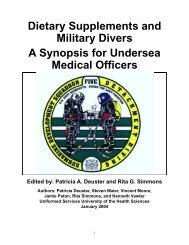Force Health Protection: Nutrition and Exercise Resource Manual
Force Health Protection: Nutrition and Exercise Resource Manual
Force Health Protection: Nutrition and Exercise Resource Manual
You also want an ePaper? Increase the reach of your titles
YUMPU automatically turns print PDFs into web optimized ePapers that Google loves.
Table 2-2. Requirements <strong>and</strong> Functions of Vitamins<br />
Fat Soluble Vitamins Some Important Functions Food Sources<br />
Vitamin A:<br />
Retinol, Retinoids, Carotene<br />
800-1,000 µg. RE or 5,000<br />
International Units (IU).<br />
Vitamin D:<br />
5-10 µg. or 200 - 400 IU.<br />
Vitamin E:<br />
alpha-Tocopherol, 8-10 mg.<br />
Vitamin K:<br />
60 - 80 µg.<br />
Growth <strong>and</strong> repair of body tissues,<br />
immune function, night vision.<br />
Carotene is the water soluble form<br />
with antioxidant properties.<br />
Regulates calcium metabolism <strong>and</strong><br />
bone mineralization.<br />
Antioxidant, protects cell<br />
membranes, <strong>and</strong> enhances immune<br />
function.<br />
Assists in blood clotting <strong>and</strong> calcium<br />
metabolism.<br />
Oatmeal, green <strong>and</strong><br />
yellow fruits <strong>and</strong><br />
vegetables, liver, milk.<br />
Fortified milk, egg yolk,<br />
salmon, sunlight.<br />
Fortified cereals, nuts,<br />
wheat germ, shrimp,<br />
green vegetables.<br />
Green <strong>and</strong> leafy<br />
vegetables.<br />
Water Soluble Vitamins Some Important Functions Food Sources<br />
Vitamin B 1 :<br />
Thiamin, 1.0 -1.5 mg.<br />
Needed in energy production, CHO<br />
metabolism, <strong>and</strong> growth. Supports<br />
muscle, nerve, <strong>and</strong> cardiovascular<br />
function.<br />
Fortified cereals,<br />
legumes, pork, nuts,<br />
organ meats,<br />
molasses, yeast.<br />
Vitamin B 2 :<br />
Riboflavin, 1.2 -1.7 mg.<br />
Vitamin B 3 : Niacin,<br />
Niacinamide, Nicotinic acid<br />
13 -19 mg.<br />
Vitamin B 5 :<br />
Pantothenic acid, 4 - 7 mg.<br />
Vitamin B 6 :<br />
Pyridoxine HCl, 2 mg.<br />
Folate:<br />
Folic acid, Folacin, 400 µg.<br />
Vitamin B 12 :<br />
Cobalamin, 2 µg.<br />
Biotin:<br />
30 - 100 µg.<br />
Vitamin C:<br />
Ascorbic acid, Ascorbate<br />
60 mg.<br />
Essential for energy metabolism;<br />
growth <strong>and</strong> tissue repair.<br />
Essential for energy metabolism,<br />
blood circulation, nerve function, <strong>and</strong><br />
appetite.<br />
Essential for energy metabolism <strong>and</strong><br />
nerve function.<br />
Essential for CHO <strong>and</strong> protein<br />
metabolism, immune function, red<br />
blood cell production, nerve function.<br />
Vital for red blood cell synthesis.<br />
Essential for the proper division of<br />
cells. Maternal folate deficiency may<br />
result in an infant with birth defects.<br />
Required for red blood cell<br />
production, energy metabolism, <strong>and</strong><br />
nerve function.<br />
Participates in energy metabolism,<br />
fatty acid formation, <strong>and</strong> utilization of<br />
the B vitamins.<br />
Antioxidant, role in growth <strong>and</strong> repair<br />
of tissues, increases resistance to<br />
infection, <strong>and</strong> supports optimal<br />
immune function.<br />
Cereals, liver, milk,<br />
yogurt, green leafy<br />
vegetables, nuts,<br />
whole grain.<br />
Lean meat, seafood,<br />
milk, yeast, fortified<br />
cereals, whole grain.<br />
Legumes, meat, fish,<br />
poultry, wheat germ,<br />
whole grain.<br />
Oatmeal <strong>and</strong> cereals,<br />
banana, plantain,<br />
poultry, liver.<br />
Fortified cereals, green<br />
leafy vegetables, liver,<br />
lentils, black-eyed<br />
peas, orange juice.<br />
Ground beef, liver,<br />
seafood, milk, cheese.<br />
Legumes, whole grain,<br />
eggs, organ meats.<br />
Cantaloupe, citrus fruit,<br />
strawberries,<br />
asparagus, cabbage,<br />
tomatoes, broccoli.<br />
From the 1989 RDA <strong>and</strong> 1998 DRIs for healthy adults 19 to 50 years. CHO = carbohydrates. mg=<br />
milligrams, µg= micrograms.<br />
<strong>Nutrition</strong> <strong>and</strong> <strong>Exercise</strong> <strong>Resource</strong> <strong>Manual</strong> 15




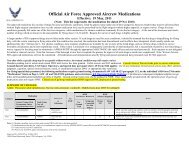

![Body Composition and Military [PDF] - Human Performance ...](https://img.yumpu.com/43269347/1/190x245/body-composition-and-military-pdf-human-performance-.jpg?quality=85)
![Tips for Grocery Shopping [PDF]](https://img.yumpu.com/37447379/1/190x245/tips-for-grocery-shopping-pdf.jpg?quality=85)
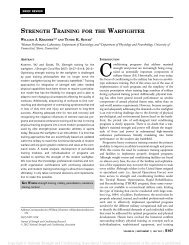
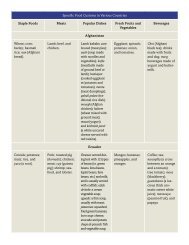
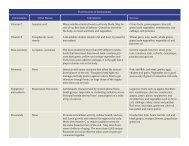
![Synthetic Drugs [PDF] - Human Performance Resource Center](https://img.yumpu.com/37447322/1/190x245/synthetic-drugs-pdf-human-performance-resource-center.jpg?quality=85)
